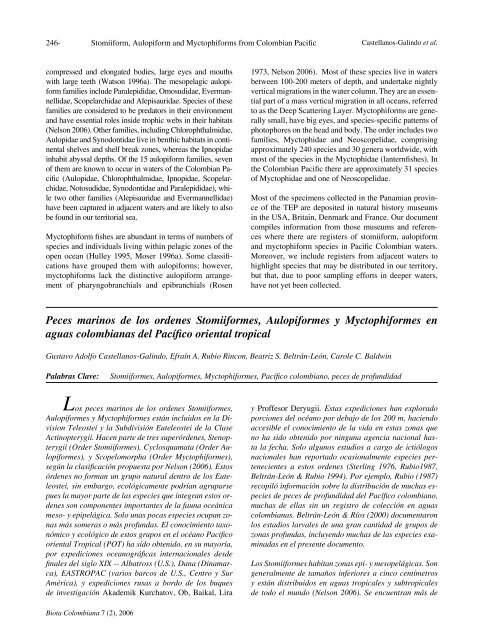Descargar este fichero PDF - Instituto de Investigación de Recursos ...
Descargar este fichero PDF - Instituto de Investigación de Recursos ...
Descargar este fichero PDF - Instituto de Investigación de Recursos ...
You also want an ePaper? Increase the reach of your titles
YUMPU automatically turns print PDFs into web optimized ePapers that Google loves.
246- Stomiiform, Aulopiform and Myctophiforms from Colombian Pacifi c Castellanos-Galindo et al.<br />
compressed and elongated bodies, large eyes and mouths<br />
with large teeth (Watson 1996a). The mesopelagic aulopiform<br />
families inclu<strong>de</strong> Paralepididae, Omosudidae, Evermannellidae,<br />
Scopelarchidae and Alepisauridae. Species of these<br />
families are consi<strong>de</strong>red to be predators in their environment<br />
and have essential roles insi<strong>de</strong> trophic webs in their habitats<br />
(Nelson 2006). Other families, including Chlorophthalmidae,<br />
Aulopidae and Synodontidae live in benthic habitats in continental<br />
shelves and shelf break zones, whereas the Ipnopidae<br />
inhabit abyssal <strong>de</strong>pths. Of the 15 aulopiform families, seven<br />
of them are known to occur in waters of the Colombian Pacific<br />
(Aulopidae, Chlorophthalmidae, Ipnopidae, Scopelarchidae,<br />
Notosudidae, Synodontidae and Paralepididae), while<br />
two other families (Alepisauridae and Evermannellidae)<br />
have been captured in adjacent waters and are likely to also<br />
be found in our territorial sea.<br />
Myctophiform fishes are abundant in terms of numbers of<br />
species and individuals living within pelagic zones of the<br />
open ocean (Hulley 1995, Moser 1996a). Some classifications<br />
have grouped them with aulopiforms; however,<br />
myctophiforms lack the distinctive aulopiform arrangement<br />
of pharyngobranchials and epibranchials (Rosen<br />
Biota Colombiana 7 (2), 2006<br />
1973, Nelson 2006). Most of these species live in waters<br />
between 100-200 meters of <strong>de</strong>pth, and un<strong>de</strong>rtake nightly<br />
vertical migrations in the water column. They are an essential<br />
part of a mass vertical migration in all oceans, referred<br />
to as the Deep Scattering Layer. Myctophiforms are generally<br />
small, have big eyes, and species-specific patterns of<br />
photophores on the head and body. The or<strong>de</strong>r inclu<strong>de</strong>s two<br />
families, Myctophidae and Neoscopelidae, comprising<br />
approximately 240 species and 30 genera worldwi<strong>de</strong>, with<br />
most of the species in the Myctophidae (lanternfishes). In<br />
the Colombian Pacific there are approximately 31 species<br />
of Myctophidae and one of Neoscopelidae.<br />
Most of the specimens collected in the Panamian province<br />
of the TEP are <strong>de</strong>posited in natural history museums<br />
in the USA, Britain, Denmark and France. Our document<br />
compiles information from those museums and references<br />
where there are registers of stomiiform, aulopiform<br />
and myctophiform species in Pacific Colombian waters.<br />
Moreover, we inclu<strong>de</strong> registers from adjacent waters to<br />
highlight species that may be distributed in our territory,<br />
but that, due to poor sampling efforts in <strong>de</strong>eper waters,<br />
have not yet been collected.<br />
Peces marinos <strong>de</strong> los or<strong>de</strong>nes Stomiiformes, Aulopiformes y Myctophiformes en<br />
aguas colombianas <strong>de</strong>l Pacífico oriental tropical<br />
Gustavo Adolfo Castellanos-Galindo, Efraín A. Rubio Rincon, Beatriz S. Beltrán-León, Carole C. Baldwin<br />
Palabras Clave: Stomiiformes, Aulopiformes, Myctophiformes, Pacífico colombiano, peces <strong>de</strong> profundidad<br />
L<br />
os peces marinos <strong>de</strong> los or<strong>de</strong>nes Stomiiformes,<br />
Aulopiformes y Myctophiformes están incluidos en la Division<br />
Teleostei y la Subdivisión Euteleostei <strong>de</strong> la Clase<br />
Actinopterygii. Hacen parte <strong>de</strong> tres superór<strong>de</strong>nes, Stenopterygii<br />
(Or<strong>de</strong>r Stomiiformes), Cyclosquamata (Or<strong>de</strong>r Aulopiformes),<br />
y Scopelomorpha (Or<strong>de</strong>r Myctophiformes),<br />
según la clasificación propuesta por Nelson (2006). Estos<br />
ór<strong>de</strong>nes no forman un grupo natural <strong>de</strong>ntro <strong>de</strong> los Euteleostei,<br />
sin embargo, ecológicamente podrían agruparse<br />
pues la mayor parte <strong>de</strong> las especies que integran estos or<strong>de</strong>nes<br />
son componentes importantes <strong>de</strong> la fauna oceánica<br />
meso- y epipelágica. Solo unas pocas especies ocupan zonas<br />
más someras o más profundas. El conocimiento taxonómico<br />
y ecológico <strong>de</strong> estos grupos en el océano Pacifico<br />
oriental Tropical (POT) ha sido obtenido, en su mayoría,<br />
por expediciones oceanográficas internacionales <strong>de</strong>s<strong>de</strong><br />
finales <strong>de</strong>l siglo XIX -- Albatross (U.S.), Dana (Dinamarca),<br />
EASTROPAC (varios barcos <strong>de</strong> U.S., Centro y Sur<br />
América), y expediciones rusas a bordo <strong>de</strong> los buques<br />
<strong>de</strong> investigación Aka<strong>de</strong>mik Kurchatov, Ob, Baikal, Lira<br />
y Proffesor Deryugii. Estas expediciones han explorado<br />
porciones <strong>de</strong>l océano por <strong>de</strong>bajo <strong>de</strong> los 200 m, haciendo<br />
accesible el conocimiento <strong>de</strong> la vida en estas zonas que<br />
no ha sido obtenido por ninguna agencia nacional hasta<br />
la fecha. Solo algunos estudios a cargo <strong>de</strong> ictiólogos<br />
nacionales han reportado ocasionalmente especies pertenecientes<br />
a estos or<strong>de</strong>nes (Sterling 1976, Rubio1987,<br />
Beltrán-León & Rubio 1994). Por ejemplo, Rubio (1987)<br />
recopiló información sobre la distribución <strong>de</strong> muchas especies<br />
<strong>de</strong> peces <strong>de</strong> profundidad <strong>de</strong>l Pacífico colombiano,<br />
muchas <strong>de</strong> ellas sin un registro <strong>de</strong> colección en aguas<br />
colombianas. Beltrán-León & Ríos (2000) documentaron<br />
los estadios larvales <strong>de</strong> una gran cantidad <strong>de</strong> grupos <strong>de</strong><br />
zonas profundas, incluyendo muchas <strong>de</strong> las especies examinadas<br />
en el presente documento.<br />
Los Stomiiformes habitan zonas epi- y mesopelágicas. Son<br />
generalmente <strong>de</strong> tamaños inferiores a cinco centímetros<br />
y están distribuidos en aguas tropicales y subtropicales<br />
<strong>de</strong> todo el mundo (Nelson 2006). Se encuentran más <strong>de</strong>


